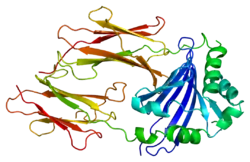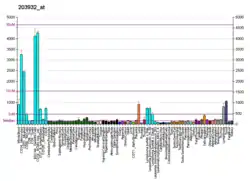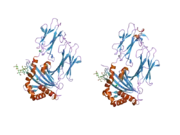HLA-DMB
HLA class II histocompatibility antigen, DM beta chain is a protein that in humans is encoded by the HLA-DMB gene.[5][6]
Function
HLA-DMB belongs to the HLA class II beta chain paralogues. This class II molecule is a heterodimer consisting of an alpha (DMA) and a beta (DMB) chain, both anchored in the membrane. It is located in intracellular vesicles. DM plays a central role in the peptide loading of MHC class II molecules by helping to release the CLIP (class II-associated invariant chain peptide) molecule from the peptide binding site. Class II molecules are expressed in antigen presenting cells (APC: B lymphocytes, dendritic cells, macrophages). The beta chain is approximately 26-28 kDa and its gene contains 6 exons. Exon one encodes the leader peptide, exons 2 and 3 encode the two extracellular domains, exon 4 encodes the transmembrane domain and exon 5 encodes the cytoplasmic tail.[6]
Clinical significance
HLA-DMB is upregulated in tumor tissue of Caucasian but not African patients. Its role in tumor immunology is undefined but has been shown to positively correlated with increased T-cell infiltration and improved prognosis in ovarian cancer. Differential immune processes mediated by HLA-DMB may contribute to the disparity in cancer outcome.[7]
References
- ENSG00000226264, ENSG00000242574, ENSG00000239329, ENSG00000234154, ENSG00000242386, ENSG00000242092, ENSG00000241296 GRCh38: Ensembl release 89: ENSG00000241674, ENSG00000226264, ENSG00000242574, ENSG00000239329, ENSG00000234154, ENSG00000242386, ENSG00000242092, ENSG00000241296 - Ensembl, May 2017
- GRCm38: Ensembl release 89: ENSMUSG00000079547 - Ensembl, May 2017
- "Human PubMed Reference:". National Center for Biotechnology Information, U.S. National Library of Medicine.
- "Mouse PubMed Reference:". National Center for Biotechnology Information, U.S. National Library of Medicine.
- Kelly AP, Monaco JJ, Cho SG, Trowsdale J (Nov 1991). "A new human HLA class II-related locus, DM". Nature. 353 (6344): 571–3. Bibcode:1991Natur.353..571K. doi:10.1038/353571a0. PMID 1922365. S2CID 3065226.
- "Entrez Gene: HLA-DMB major histocompatibility complex, class II, DM beta".
- Kinseth MA, Jia Z, Rahmatpanah F, Sawyers A, Sutton M, Wang-Rodriguez J, Mercola D, McGuire KL (Jan 2014). "Expression differences between African American and Caucasian prostate cancer tissue reveals that stroma is the site of aggressive changes". International Journal of Cancer. 134 (1): 81–91. doi:10.1002/ijc.28326. PMC 3800217. PMID 23754304.
Further reading
- Vogt AB, Kropshofer H (1999). "HLA-DM - an endosomal and lysosomal chaperone for the immune system". Trends Biochem. Sci. 24 (4): 150–4. doi:10.1016/S0968-0004(99)01364-X. PMID 10322421.
- Kropshofer H, Hämmerling GJ, Vogt AB (2000). "The impact of the non-classical MHC proteins HLA-DM and HLA-DO on loading of MHC class II molecules". Immunol. Rev. 172: 267–78. doi:10.1111/j.1600-065X.1999.tb01371.x. PMID 10631952. S2CID 22216172.
- Piatier-Tonneau D, Gastinel LN, Amblard F, et al. (1991). "Interaction of CD4 with HLA class II antigens and HIV gp120". Immunogenetics. 34 (2): 121–8. doi:10.1007/BF00211424. PMID 1869305. S2CID 10116507.
- Rosenstein Y, Burakoff SJ, Herrmann SH (1990). "HIV-gp120 can block CD4-class II MHC-mediated adhesion". J. Immunol. 144 (2): 526–31. PMID 1967269.
- Bowman MR, MacFerrin KD, Schreiber SL, Burakoff SJ (1991). "Identification and structural analysis of residues in the V1 region of CD4 involved in interaction with human immunodeficiency virus envelope glycoprotein gp120 and class II major histocompatibility complex molecules". Proc. Natl. Acad. Sci. U.S.A. 87 (22): 9052–6. doi:10.1073/pnas.87.22.9052. PMC 55099. PMID 1978941.
- Clayton LK, Sieh M, Pious DA, Reinherz EL (1989). "Identification of human CD4 residues affecting class II MHC versus HIV-1 gp120 binding". Nature. 339 (6225): 548–51. Bibcode:1989Natur.339..548C. doi:10.1038/339548a0. PMID 2543930. S2CID 4246781.
- Diamond DC, Sleckman BP, Gregory T, et al. (1988). "Inhibition of CD4+ T cell function by the HIV envelope protein, gp120". J. Immunol. 141 (11): 3715–7. PMID 2846691.
- Andrieu JM, Even P, Venet A (1986). "AIDS and related syndromes as a viral-induced autoimmune disease of the immune system: an anti-MHC II disorder. Therapeutic implications". AIDS Research. 2 (3): 163–74. doi:10.1089/aid.1.1986.2.163. PMID 3489470.
- Houlgatte R, Scarmato P, el Marhomy S, et al. (1994). "HLA class II antigens and the HIV envelope glycoprotein gp120 bind to the same face of CD4". J. Immunol. 152 (9): 4475–88. PMID 7512597.
- Shaman J, von Scheven E, Morris P, et al. (1995). "Analysis of HLA-DMB mutants and -DMB genomic structure". Immunogenetics. 41 (2–3): 117–24. doi:10.1007/BF00182322. PMID 7528727. S2CID 40078535.
- Chirmule N, McCloskey TW, Hu R, et al. (1995). "HIV gp120 inhibits T cell activation by interfering with expression of costimulatory molecules CD40 ligand and CD80 (B71)". J. Immunol. 155 (2): 917–24. PMID 7541827.
- Rowell JF, Stanhope PE, Siliciano RF (1995). "Endocytosis of endogenously synthesized HIV-1 envelope protein. Mechanism and role in processing for association with class II MHC". J. Immunol. 155 (1): 473–88. PMID 7602119.
- Sherman MA, Weber DA, Jensen PE (1995). "DM enhances peptide binding to class II MHC by release of invariant chain-derived peptide". Immunity. 3 (2): 197–205. doi:10.1016/1074-7613(95)90089-6. PMID 7648393.
- Radley E, Alderton RP, Kelly A, et al. (1994). "Genomic organization of HLA-DMA and HLA-DMB. Comparison of the gene organization of all six class II families in the human major histocompatibility complex". J. Biol. Chem. 269 (29): 18834–8. PMID 8034636.
- Chen YH, Böck G, Vornhagen R, et al. (1994). "HIV-1 gp41 binding proteins and antibodies to gp41 could inhibit enhancement of human Raji cell MHC class I and II expression by gp41". Mol. Immunol. 31 (13): 977–82. doi:10.1016/0161-5890(94)90092-2. PMID 8084338.
- Fling SP, Arp B, Pious D (1994). "HLA-DMA and -DMB genes are both required for MHC class II/peptide complex formation in antigen-presenting cells". Nature. 368 (6471): 554–8. Bibcode:1994Natur.368..554F. doi:10.1038/368554a0. PMID 8139690. S2CID 4307699.
- Chirmule N, Wang XP, Hu R, et al. (1994). "Envelope glycoproteins of HIV-1 interfere with T-cell-dependent B cell differentiation: role of CD4-MHC class II interaction in the effector phase of T cell help". Cell. Immunol. 155 (1): 169–82. doi:10.1006/cimm.1994.1110. PMID 8168144.
- Sanderson F, Powis SH, Kelly AP, Trowsdale J (1993). "Limited polymorphism in HLA-DM does not involve the peptide binding groove". Immunogenetics. 39 (1): 56–8. doi:10.1007/bf00171797. PMID 8225438. S2CID 27369392.
- Callahan KM, Rowell JF, Soloski MJ, et al. (1993). "HIV-1 envelope protein is expressed on the surface of infected cells before its processing and presentation to class II-restricted T lymphocytes". J. Immunol. 151 (6): 2928–42. PMID 8376762.







